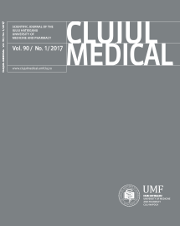PROPOSED SCORE FOR THE SELF-ASSESSMENT OF AN ENDOSCOPY DEPARTMENT PERFORMANCE IN COLONOSCOPY SCREENING
DOI:
https://doi.org/10.15386/cjmed-730Keywords:
screening colonoscopy, quality assurance, performance, self-assessmentAbstract
The aim of the paper was to propose a score for performance evaluation in colonoscopy units.
Method. We proposed a score (CDCD score - Cecal intubation, polyp Detection rate, Cleansing and Documentation of cecal intubation) based on the following parameters that assess the quality of colonoscopy units: total colonoscopies rate, polyp detection rate, rate of cecal intubation photo record, rate of recorded Boston bowel preparation scale (BBPS) (rated 1 to 5 stars). The mean score obtained based on the above mentioned criteria was used as a quality parameter of the endoscopy unit.
We applied and calculated this score in all screening colonoscopies performed in our Endoscopy Department during the last 4 years.
Results. The study group included 856 screening colonoscopies. The rate of total colonoscopies was 92.1% (789/856 cases) and the polyp detection rate was 23.9%. Regarding the quality of bowel preparation, the BBPS was recorded in 51.1% cases. The cecal intubation was photo recorded in 44% of cases.
We considered that of the 4 parameters, the highest weight for an excellent quality belonged to the cecal intubation rate, followed by the polyp detection rate, because they evaluate the endoscopic technique, while the other 2 are more administrative. Thus, for the unit’s assessment we used the following equation: UNIT’S QUALITY CDCD SCORE = (3xcecal intubation rate+3xpolyp detection rate+1xphoto documentation+1xBBPS documentation)/8. Thus, the CDCD Score for our unit was ≈4 stars (3.7 stars).
Conclusion. the proposed CDCD score may be an objective tool for the quality assessment in different endoscopy units.
Downloads
Published
How to Cite
Issue
Section
License
The authors are required to transfer the copyright of the published paper to the journal. This is done by agreeing to sign the Copyright Assignment Form. Whenever the case, authors are also required to send permissions to reproduce material (such as illustrations) from the copyright holder.

The papers published in the journal are licensed under a Creative Commons Attribution-NonCommercial-NoDerivatives 4.0 International License.

